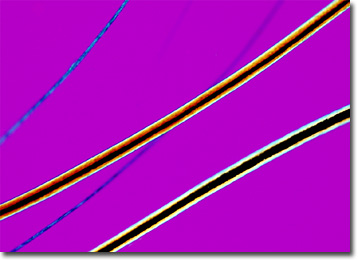Polarized Light Microscopy Digital Image Gallery
Raccoon Hair
Inquisitive and intelligent, raccoons are omnivores that have a reputation for getting into most anything, including garbage. They are, therefore, often considered pests, especially by farmers who fear for the security of their crops and chicken coops.

View a second image of Raccoon Hair
Native to the New World, raccoons prefer to inhabit wooded areas, but have adapted to numerous locales, including populous cities. Adept climbers, the mammals frequently construct their dens in tree hollows far from the ground, but may also settle in abandoned buildings, houses, burrows, caves, or just about any other sheltered place. They do prefer, however, to live near water if possible, though they do not enjoy swimming and their coats are not waterproof. When they capture food, raccoons have an unusual habit of dipping the item into water, perhaps to wash it before eating, using their slender, humanlike hands.
Raccoons have a natural lifespan of about 16 years, but in the wild do not typically survive past the age of two due to trapping and hunting by humans. Part of this hunting is carried out by those who want to simply eradicate the animals because of the destruction they can cause to crops and other property, while others pursue the animals because they are common transmitters of rabies, especially in the southeastern United States. Raccoons are also sought after by humans in order that they may be exploited for commercial profit. The distinctive shaggy pelts of the animals have, for instance, been an important commodity in the fur trade for many years and are used to construct items such as coats and coonskin caps. In the fashion industry, raccoon fur is sometimes promoted as an imitation variety of more expensive furs, such as those of mink or otter.
